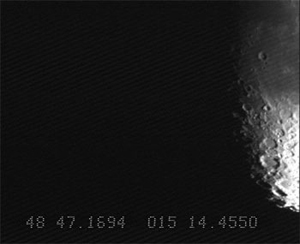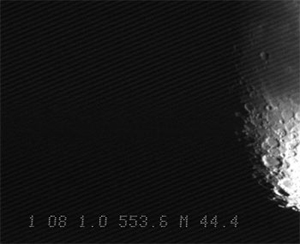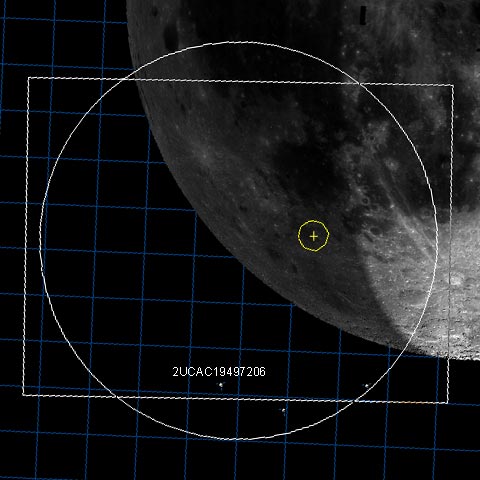The ESA spacecraft SMART-1 was launched on 27. September 2003 on board of a Ariane-5 and reached, driven by a ion propulsion, after many modifications of trajectory in November 2004 finally the moon orbit. Since March 2005 scientifically observations of the moon were done. The livetime of SMART-1 ended as designated after another 16 months in September 2006. To use the impact on moon surface also for scientific it was planned to crash controlled and not at random. Thereby several data from earth and from earthorbit should be taken.
So since the first half of the year 2006 all interested astronomers, profis and amateurs, were invited by ESA to record the impact place before and after crash and record crash itself with appropriate instruments. The time of impact was determined by ESA to give big observatories from South America to Hawaii the best conditions for recording.
Estimations offered also a chance for 10 inch telescopes in conjunction with appropriate filter- and video technics to catch the impact flash on the dark side of the moon. The one meter sized spacecraft would alter at the crash with 2 kilometer per second and a mass of 350 kilogramms a kinetic energy of 700 Megajoule. Thereby the remaining 3 kilogramms Hydrazin could cause an additional flash. An impact flash would shine mainly in infrared.
The estimated impact should occur on 03. September 2006 at 05:42:20.320 (UTC). An impact at this time was not visible from Europe because the moon was deep below the northwest horizon. But there was a little chance that the impact could unexpected happen two orbits earlier. So for observers in Europe the Nominal Impact Orbit -2 was the only one reasonable observation. This point of time was on 02. September 2006 at 19:32:56.631 (UTC) = 21:32:56.631 MESZ.
Perilune Passage: Nominal Impact Orbit -2 (source:ESA)
Time: 2006/09/02 19:32:56.631 (UTC)
Longitude 319.26963343790°
Latitude -36.48068123967°
Height (topograph) 3336.417 (m)
Position vector in Mean Equatorial 2000, Earth centred
X-Axis Component 18506.4917583 (km) (MEQ2T)
Y-Axis Component -330645.8322386 (km) (MEQ2T)
Z-Axis Component -182194.4186395 (km) (MEQ2T)
Because there was a little chance to catch the event with my equipment I planned an observation and a record for evening of 02. September 2006.
Used equipment
Newton telescope 1200/254mm
Parallactic mount EQ6
JMI NGF-DX1 motor-focuser + Atik filterwheel
Planet IR Pro 807 filter from Astronomik
Videocamera WAT-120N
VideoTimeInserter KIWI-OSD with GPS Garmin 18 LVC
Notebook + videograbber
The beginning was promising. Due to the attenuation of the 807nm IR-filter the integration time and gain of videocamera could be adjusted relative good to show the difficult light situation on terminator in useable quality. The brightness was adjusted so that the lit moon area did not expand. So the +8.52 mag star 2UCAC19497206 could be seen near the dark moon side in a good condition live on screen. I estimated that I could capture a infrared-flash on video down to a magnitude of around +9.5 mag.
Due to the 807nm infraredfilter the moon standing only 10 degrees about the south horizon was relative stable on video image. The growing moon was lit to 69 percent on this evening and made the environment bright. But during such observations the light pollution from town Waidhofen/Thaya in 4 kilometer distance also did not disturb.
The observation position near Nonndorf about 4 kilometers southwest from Waidhofen/Thaya Star Algol in northeast seems to be lit by two spots of the church |
After a setup and adjusting time of about 40 minutes the target area on moon was clear visible in video on notebook display and the GPS time insertion by KIWI-OSD was running perfect. And I had another 20 minutes to video recording start at 19:30 UT as planned.
But at around 19:20 UT once again it was shown to me that the law of Murphy always is valid and one has always to reckon with it. Suddenly a small bank of clouds was fast moving from west in direction to the moon, covered the moon and slowed down. So all video records in this minutes of estimated possible spacecraft crash were prevented.
A fast coming bank of clouds covered the area around the moon |
Only some minutes later the moon could be seen on notebook display shining through the clouds. But now it was to late and the moon was still covered to much by this clouds. Here are some downsized video images showing inserted information from KIWI-OSD.
Video image with time information | Video image with date information | |
Video image with latitude and longitude | Video image with SAT- and altitude data |
The Guide8 grafic below shows the estimated crash area in the "Lake of Excellence" on moon nearby the bright-dark limit, the terminator.
The estimated impact area of SMART-1 on moon |
On next day the confirmation arrived. The ESA spacecraft SMART-1 hit the moon surface in Nominal Impact Orbit on 03. September 2006 at 05h42m21.759s UTC. At this point of time the ESA ground station in New Norcia, Australia, lost signal from spacecraft and the 3.6 meter Canada-France-Hawaii-Telescope CFHT in Hawaii on Mauna Kea simultaneously captured a flash in impact area.
To place the time of impact sure on 03. September 2006 ESA rised in a last trajectory modification on 02. September 2006 the deepest orbit point of the spacecraft by 562 meters.
Conclusion
Although clouds prevented records in the right moment I could obtain another important experience with my video equipment and infrared filter. So this evening was not really a lost one.
09. September 2006 |
|
Site Home |